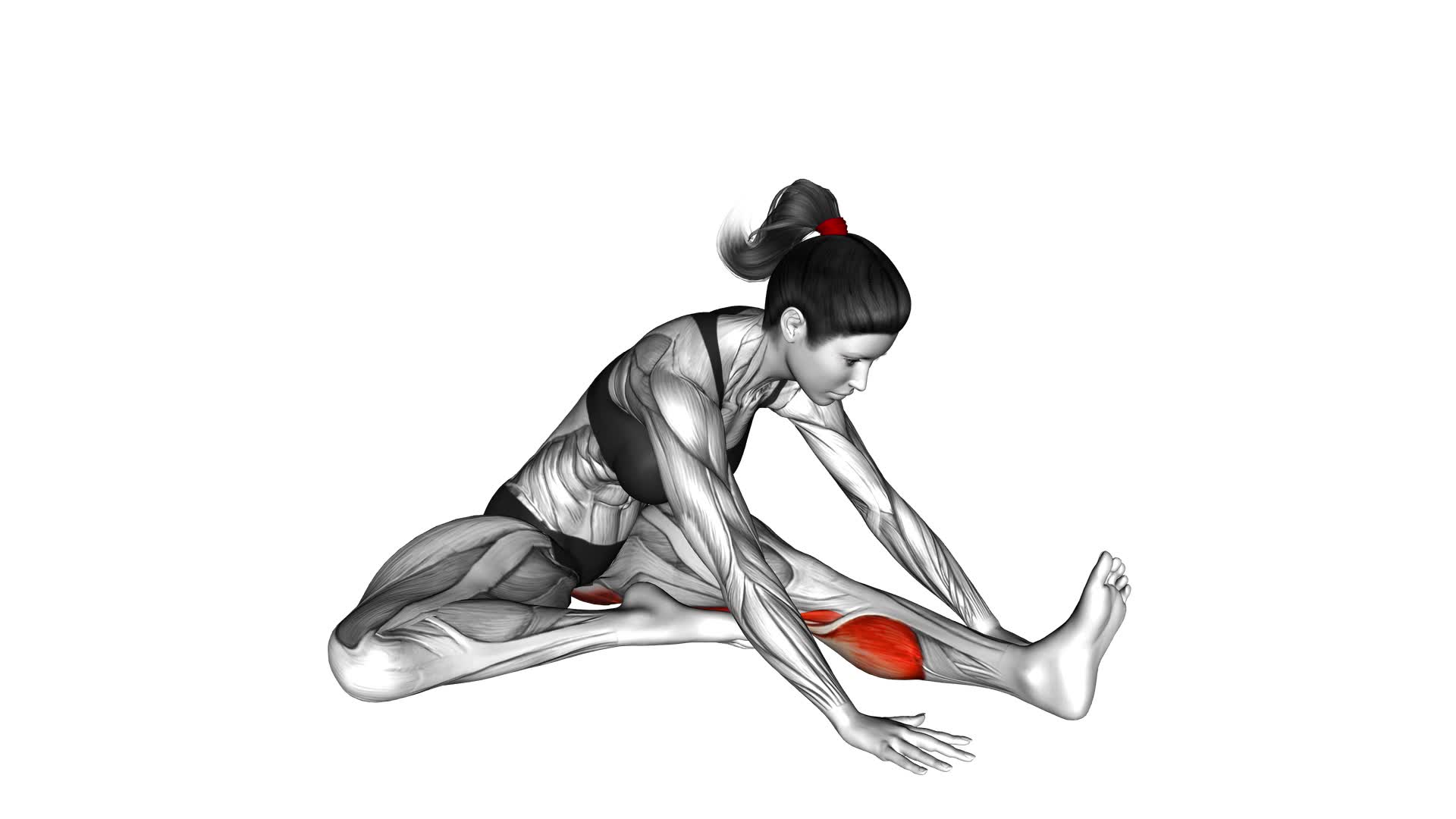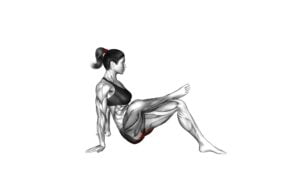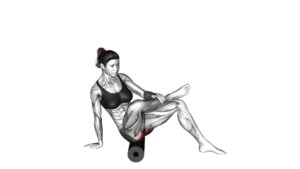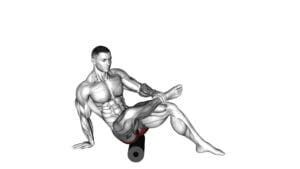Seated Hip External Rotator And Hip Extensor Stretch (female) – Video Exercise Guide & Tips

Are you looking for a quick and effective way to stretch your hip muscles? Look no further than the Seated Hip External Rotator and Hip Extensor Stretch.
Watch This Exercise Video
In this video exercise guide, we'll show you how to properly perform this stretch to improve flexibility and reduce tightness. Whether you're a beginner or an advanced fitness enthusiast, we've got modifications and variations to suit your needs.
Don't miss out on these helpful tips to maximize the effectiveness of your stretch. Let's get started!
Key Takeaways
- Seated Hip External Rotator and Hip Extensor Stretch targets hip muscles to improve flexibility and prevent injuries.
- The stretch increases range of motion in the hips for better performance in activities.
- It alleviates tightness and discomfort in the hip area.
- The exercise strengthens hip muscles and stabilizes the hip joint.
Benefits of the Seated Hip External Rotator and Hip Extensor Stretch
Discover the numerous benefits you can experience by incorporating the Seated Hip External Rotator and Hip Extensor Stretch into your fitness routine. This exercise specifically targets the hip muscles, helping to improve flexibility and prevent hip injuries.
By regularly performing the Seated Hip External Rotator and Hip Extensor Stretch, you can significantly increase the range of motion in your hips. This improved flexibility can enhance your performance in various activities, such as running, dancing, and sports that require hip mobility. Additionally, it can help alleviate tightness and discomfort in the hip area, allowing you to move more freely and comfortably.
Incorporating this stretch into your routine can also be beneficial in preventing hip injuries. Strengthening the hip muscles and increasing their flexibility can help stabilize the hip joint, reducing the risk of strains, sprains, and other injuries. It can also improve your posture and alignment, which can further decrease the likelihood of hip issues.
Make sure to properly warm up before performing the Seated Hip External Rotator and Hip Extensor Stretch to maximize its benefits and prevent any potential injuries. Consult with a fitness professional to learn the correct technique and modifications based on your fitness level and any pre-existing conditions.
Incorporating the Seated Hip External Rotator and Hip Extensor Stretch into your fitness routine can have a significant positive impact on your flexibility and help prevent hip injuries. Start reaping these benefits by adding this exercise to your regular workout regimen.
Proper Form and Technique for the Exercise
To perform the Seated Hip External Rotator and Hip Extensor Stretch correctly, position yourself in a seated position with your legs extended in front of you. Sit up tall, with your back straight and shoulders relaxed. Place your hands on the ground behind you for support.
One common misconception about this exercise is that you need to forcefully push your knees down towards the ground. However, this can strain your hip joints and lead to injury. Instead, focus on gently rotating your hips outward and lengthening through the spine.
To deepen the stretch, you can gently lean forward, keeping your back straight. This will target the hip extensors and increase the intensity of the stretch. Remember to breathe deeply and relax into the stretch, avoiding any pain or discomfort.
If you find it difficult to perform the Seated Hip External Rotator and Hip Extensor Stretch, there are alternative exercises you can try. One option is the lying hip external rotation stretch, where you lie on your back and cross one leg over the other, gently pressing the crossed leg down towards the ground.
Another alternative is the standing hip external rotation stretch, where you stand with one foot crossed over the other and gently rotate your hips outward.
Remember to consult with a healthcare professional before starting any new exercise routine, especially if you have any pre-existing conditions or injuries.
Common Mistakes to Avoid During the Stretch
One common mistake to avoid during the Seated Hip External Rotator and Hip Extensor Stretch is forcefully pushing your knees down towards the ground, as this can strain your hip joints and lead to injury.
To ensure you're performing the stretch correctly and safely, keep the following tips in mind:
- Avoid bouncing: While it may be tempting to bounce your knees up and down, this can put unnecessary stress on your hip joints. Instead, focus on maintaining a steady and controlled movement.
- Do not overstretch: It's important to find a comfortable range of motion when performing this stretch. Avoid pushing yourself too far or trying to force your knees closer to the ground. Listen to your body and stop if you feel any pain or discomfort.
- Maintain proper posture: Keep your back straight and your core engaged throughout the stretch. Avoid rounding your shoulders or slouching forward, as this can affect the effectiveness of the stretch.
- Breathe and relax: Remember to breathe deeply and relax your muscles during the stretch. Holding your breath or tensing up can hinder your flexibility and make the stretch less effective.
Modifications and Variations for Different Fitness Levels
Continue the discussion from the previous subtopic by exploring modifications and variations for different fitness levels.
It's important to understand that not everyone has the same level of flexibility or strength, and modifications can be made to accommodate different fitness levels while still reaping the benefits of the seated hip external rotator and hip extensor stretch.
For individuals who are new to stretching or have limited flexibility, it's recommended to start with a modified version of the stretch. Instead of crossing one leg over the other, keep both feet flat on the ground and gently lean forward to feel a stretch in the hip and glute muscles. This modification allows for a more comfortable stretch while still targeting the same muscle groups.
On the other hand, for individuals who are more advanced or have greater flexibility, the stretch can be intensified by adding resistance. This can be done by placing a resistance band around the knees and pushing outward against the band while performing the stretch. This modification increases muscle activation and can further enhance the benefits of the stretch.
Regardless of the fitness level, it's important to focus on proper form and technique during the stretch to prevent injury. Engage the core muscles, maintain an upright posture, and avoid any excessive or jerky movements.
Tips for Maximizing the Effectiveness of the Stretch
Maximize the effectiveness of the stretch by incorporating these tips into your routine:
- Warm up before stretching: Prior to performing the seated hip external rotator and hip extensor stretch, it's essential to warm up your muscles. Engage in some light cardio exercises such as jogging or jumping jacks for about 5-10 minutes. This will increase blood flow to the muscles and prepare them for stretching, maximizing flexibility.
- Hold the stretch for an adequate duration: To reap the full benefits of this stretch, hold each position for 30-60 seconds. This allows enough time for your muscles to relax and lengthen. Avoid rushing through the stretch, as it may not provide the desired results. Remember, patience is key when it comes to stretching.
- Breathe and relax: While performing the stretch, take deep breaths and consciously try to relax your muscles. Tension can hinder the effectiveness of the stretch, so focus on releasing any tightness or discomfort. Breathing deeply also helps to oxygenate your muscles, enhancing their flexibility.
- Gradually increase the intensity: Start with a gentle stretch and gradually increase the intensity over time. Push yourself to a comfortable limit, but never force the stretch to the point of pain. Remember, the goal is to improve flexibility, not to cause injury.
Precautions and Contraindications for the Exercise
To ensure safe and effective practice of the seated hip external rotator and hip extensor stretch, it's important to be aware of the precautions and contraindications for this exercise. Safety precautions are necessary to prevent injury and ensure that you get the most out of your stretching routine.
Firstly, it's important to listen to your body and avoid pushing yourself too hard. If you feel any pain or discomfort during the stretch, stop immediately.
Additionally, make sure to warm up properly before attempting this stretch to prepare your muscles and joints.
If you have any pre-existing hip or lower back injuries, it's crucial to consult with a healthcare professional before attempting this exercise. They'll be able to provide personalized advice and guidance based on your specific condition.
If you find that the seated hip external rotator and hip extensor stretch isn't suitable for you, there are alternative stretches that can target the same muscles. Some options include the seated figure-four stretch or the supine hamstring stretch.
Frequently Asked Questions
How Long Should I Hold the Seated Hip External Rotator and Hip Extensor Stretch?
To effectively perform the seated hip external rotator and hip extensor stretch, it's important to know how long to hold the stretch. Holding it for 20-30 seconds is recommended, as this allows enough time for the muscles to stretch and relax.
Incorporating this stretch into your daily routine can bring various benefits, such as improved hip mobility, increased flexibility, and reduced risk of hip and lower back pain.
Can I Perform This Stretch if I Have a Hip Injury?
If you have a hip injury, it's important to take precautions when performing this stretch. Consult with a healthcare professional for advice on modifications that can be made to accommodate your injury.
It's crucial to prioritize your safety and avoid aggravating your condition. With proper guidance, you can still benefit from stretching exercises that target the hip muscles while minimizing the risk of further injury.
Is It Necessary to Warm up Before Doing This Stretch?
Before performing any stretch, it's important for you to warm up your body. Warming up helps increase blood flow to your muscles, making them more flexible and less prone to injury.
There are different types of warm up exercises you can do, such as light jogging, jumping jacks, or dynamic stretches. By warming up properly, you prepare your body for the stretch and maximize its benefits.
Can I Do This Stretch if I Have Lower Back Pain?
Yes, you can still do this stretch if you have lower back pain. However, it's important to listen to your body and not push yourself too hard.
Stretching exercises can actually help relieve lower back pain by improving flexibility and reducing muscle tension. Just make sure to start slowly and gently, and stop if you feel any sharp or worsening pain.
It may also be helpful to consult with a healthcare professional for personalized advice.
How Often Should I Incorporate This Stretch Into My Workout Routine?
To optimize your workout routine, it's important to consider the stretching frequency and optimal stretch duration. When it comes to incorporating this stretch, it's recommended to perform it 2-3 times a week. However, it's also crucial to listen to your body and not overdo it.
Aim for a stretch duration of around 20-30 seconds per side. This will help improve flexibility and prevent any potential muscle imbalances or injuries.
Conclusion
The seated hip external rotator and hip extensor stretch is a beneficial exercise for improving hip mobility and flexibility. By maintaining proper form and technique, avoiding common mistakes, and making modifications for different fitness levels, individuals can maximize the effectiveness of the stretch.
However, it's important to exercise caution and be aware of any precautions or contraindications before attempting this exercise.
Incorporating this stretch into your routine can help enhance your overall hip strength and range of motion.

Author
Years ago, the spark of my life’s passion ignited in my mind the moment I stepped into the local gym for the first time. The inaugural bead of perspiration, the initial endeavor, the very first surge of endorphins, and a sense of pride that washed over me post-workout marked the beginning of my deep-seated interest in strength sports, fitness, and sports nutrition. This very curiosity blossomed rapidly into a profound fascination, propelling me to earn a Master’s degree in Physical Education from the Academy of Physical Education in Krakow, followed by a Sports Manager diploma from the Jagiellonian University. My journey of growth led me to gain more specialized qualifications, such as being a certified personal trainer with a focus on sports dietetics, a lifeguard, and an instructor for wellness and corrective gymnastics. Theoretical knowledge paired seamlessly with practical experience, reinforcing my belief that the transformation of individuals under my guidance was also a reflection of my personal growth. This belief holds true even today. Each day, I strive to push the boundaries and explore new realms. These realms gently elevate me to greater heights. The unique combination of passion for my field and the continuous quest for growth fuels my drive to break new ground.







